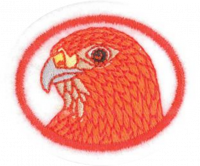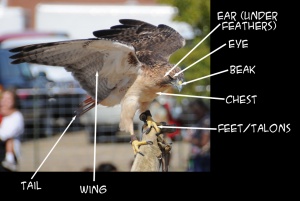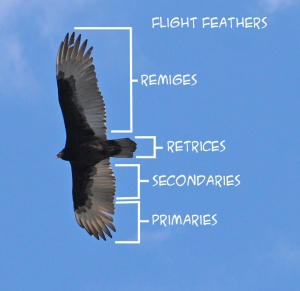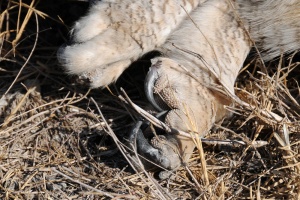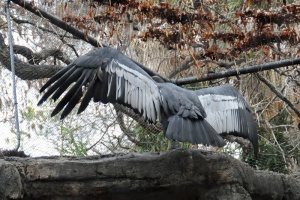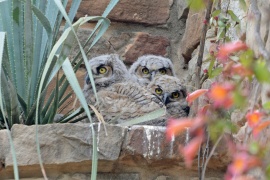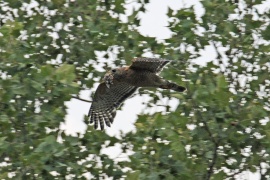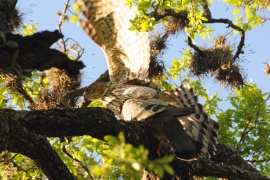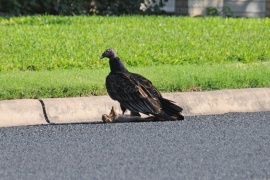Especialidades JA/Aves de rapiña/Respuestas
Nivel de destreza
1
Año
2015
Version
09.11.2025
Autoridad de aprobación
División Norteamericana
1
2
2a
2b
2c
Talons/Feet: With the exception of the vultures (Cathartidae), most raptors capture their live prey with their feet/talons. The feet are strong, and in diurnal raptors the lower legs are often bare (whereas many owls may have feathers even on their feet). The claws may be long and strongly curved, as in Osprey or falcons that catch fish or birds on the wing, or shorter for raptors hunting much larger prey. Most raptors have three toes facing forward and a fourth facing backwards, but owls and osprey can turn their small tow backwards, to have a two two configuration, for better balance or grip.
2d
3
- a. Ojos
- b. Pies y garras
- c. Pecho
- d. Cuerpo
- e. Pico
- f. Oídos
- g. Alas
- h. Plumas
The third picture above is a close up shot of owl talons. Note the sharp, curved claws, used for grasping prey.
4
4a
4b
The largest diurnal raptor by wingspan is the Andean Condor (image below), measuring in at 10 feet or more across. By weight, it is the California Condor, at 31 pounds.
The largest nocturnal raptor by weight is either the Eurasian Eagle-Owl, measuring 2-2.5 feet with a wingspan of 5-6 feet (weighing 3-9 pounds), or the endangered Blakiston’s Fish Owl, measuring 2-2.3 feet and weighing 6.5-10 pounds. By size (but not weight), the Great Grey Owl tops both, measuring 2-2.75 feet with a wingspan of up to five feet, but weighing in at only 1.3 to slightly over 4 pounds.
By comparison, the largest parrots, the Hyacinth Macaw, can reach a length of some 3.3 feet, and the flightless Kakapo can weigh up to 4.5 pounds, and the largest waterfowl are the Trumpeter Swan, with a 10 foot wingspan and weighing in at some 38 pounds.
4c
As would be expected from such a diverse group, raptors build many different types of nests.
Some build large stick nests, among them the Bald Eagles, Osprey, Secretarybird, Crested Caracara, and Red-Shouldered Hawk. Osprey nests are usually atop a solitary pole, Caracara may place their nests atop a small tree or palm.
Others scrape out nesting sites on cliffs, such as the Peregrine Falcon, or the Merlin (which may also use old nests of other raptors).
Several types of owls nest in natural cavities in trees, including the Screech Owl, while the Elf Owl prefers to nest in old woodpecker holes in Cacti. The Common Kestrel is another cavity nester.
Most vultures do not bother building nests at all, laying their eggs in tall grasses, natural hollows in rocks or on cliffs, or in fallen hollow logs.
The Burrowing Owl, as its name suggests, prefers to nest in ground burrows, usually ones abandoned by mammals.
4d
Among the raptors, a general rule is that the smaller the species, the shorter the lifespan. Small raptors live 3-15 years, though for nearly all raptors, the first 1-3 years are the most dangerous, and the time they are most likely to be killed prematurely. Larger raptors live 20-40 years, and perhaps even longer in captivity for some species.
Like the raptors, smaller parrots have shorter lifespans, perhaps some 15-20 years, while the larger species may live 80 or more years. For waterfowl, some geese may live well over 20 years, while other ducks may have shorter average lifespans, in the 8-20 year range.
4e
With the exception of the vultures (Cathartidae) which are carrion-eating scavengers, most raptors are active hunters, using their keen eyesight (watch them flying, and you will often see their head cocked to one side looking down) to find prey, and their sharp talons to capture the prey. Most falcons (Falconidae), as well as some Kites and other Accipiters, have a well developed extra "bump" on the outer edge of their upper mandible (beak) just behind the curved tip. This is referred to as the Tomial "tooth," and is thought to assist the falcons in quickly killing their captured prey by severing the spinal column.
The vultures are primarily carrion eaters, feeding on dead animals and the occasional invertebrate, lizard or amphibian or at times even small or young mammals. The Lesser Yellow-Headed Vulture prefers dead fish, the Turkey Vulture prefers smaller mammals, and the Black Vulture is known to eat just about anything dead.
Secretarybirds hunt small mammals, reptiles, birds and invertebrates.
Osprey are almost exclusively fish eaters, catching fish out of the water with their talons.
Falcons feed on many different types of live prey, including live birds (the Peregrine Falcon is particularly adept at catching birds on the wing).
Smaller hawks may prefer reptiles and amphibians and smaller mammals like rodents, larger hawks and eagles may tackle even bigger live prey, including rabbits and ducks. Smaller Accipiters and Falcons feed on insects.
Owls are frequently known for their affinity for small mammals, particularly rodents.
Bearded Vultures like to eat Ostrich eggs, among other things. Their beaks are not strong enough to pierce the thick shell, so they throw rocks at the eggs until they crack open.
The Snail Kite, as its name implies, has a beak suited for prying snails out of their shells, and feeds mostly on apple snails.
4f
Raptors like hawks and eagles swallow their prey whole or if it can’t be swallowed whole they use their sharp beaks to pierce prey, pull of fur, tug away skin, pluck out feathers and tear meat into bite-sized, easy to swallow chunks. They also have a “tooth” tucked inside their upper beak. This “tooth” is shaped like a small triangle and is called a tomila. The tomila helps the raptor kill its prey quickly by cutting the prey’s spinal cord.
Raptors like owls swallow their food whole if they can. The food goes directly from their mouth to their gizzard. They later regurgitate pellets of indigestible materials such as bone, fur and feathers. This is called a “pellet.” You can tell the diet of an owl by what is found in the pellet.
5
5a
| Tip for earning from home during the pandemic | |
| Check with your local raptor conservation organizations and see if they can make a presentation to your group via video conferencing. Otherwise, choose one of the other options. |
This can be done as part of Requirement #7. If going to a zoo or wildlife refuge be sure to plan the visit or prearrange for a demonstration of raptors.
5b
You can choose from this list or find another. Try your local library!
- First Sight: Birds of Prey by Kate Petty, Shooting Star Press, 1995
- Birds of Prey, ZooBooks
- Eagles, ZooBooks
- Birds of the World, Eyewitness Handbook, DK Publishing 1993
- Birds of Prey Coloring book by John Green
- Birds of Prey from Falcons to Vultures by Sara Swan Miller, Franklin Watts, 2001
- Vultures by Sandra Markle, Lerner Publications Company 2005
- Birds of Prey: A look at Daytime Raptors by Sneed B Collard III, Grolier Publishing 1999
- Extreme Birds by Dominic Couzens, Firefly Books 2008
5c
Here is one possibility:
6
6a
See the Puppetry honor for tips on doing this.
6b
This site features an online owl pellet dissection app. You can also order actual owl pellets online and dissect them. Most pellet suppliers also offer toolkits for this.
6c
6d
6e
6f
6g
This can be done while visiting a zoo under Requirement #7 or while working on some of the activities of this honor.
7
7a
A docent is a person, often a volunteer, that provides information and tours.
Si piensa visitar un zoológico o acuario, tenga en cuenta que hay varias especialidades que tienen requisitos que se pueden cumplir visitando un zoológico o acuario. Los individuos pueden trabajar en varias especialidades en una visita, o partes de su grupo pueden trabajar en diferentes especialidades durante la misma visita.
Aquí hay una lista de especialidades que tienen requisitos que se pueden cumplir visitando un zoológico o acuario:
Bosques templados caducifolios
7b
| Tip for earning from home during the pandemic | |
| This may be possible via video conferencing. Check with your local raptor conservation organizations to find out. |
8
The National Audubon Society is one possible resource for this. They run hundreds of nature centers and are usually located in an area frequented by many species of birds. Many such nature centers are located near urban areas.
Raptors live outside of Audubon Society nature centers as well. Many cities have thriving populations of raptors. The trick is to get outside, keep your eyes open, spend time looking, and recognize them when they appear.
While looking for raptors, you could work on the Birds honor at the same time.
9
There are many mentions of raptors in the Bible. Practice using a concordance in your search (something you need to do for Explorer class Investiture Achievement). Depending upon the version, there may be different translated names, but in general you will be able to find eagle, owl, falcon, kite, osprey, and vulture.
Eagles generally denote speed, power, strength and might, as well as something largely unreachable and untamable.
- God is represented as a powerful eagle, as protecting his people or carrying them out of trouble (Ex. 19:4, Deut. 32:11, Rev. 12:14, Ezek. 7:1-10)
- The eagle may be a symbol of strength, youth and revival (Ps. 105:3, Is. 40:28-31)
- Just as the eagle can be seen as powerful for good, it can also represent the power of destruction, often as either a tool of God’s wrath, or as a the power of an overwhelming enemy (Deut. 28:49, Jer. 4:13, Jer. 48:40, Jer. 49:22, Lam. 4:19, Hos. 8:1, Hab. 1:8)
- Eagles are fast, and are used as a comparison to speed, or to things being snatched away or fleeting (2 Sam. 1:23, Job 9:26, Prov. 23:5)
- The soaring height of eagles and their nests hidden in high rocky crags represents distance - a distance that is easily overcome by God (Jer. 49:16, Ob. 1:4)
- Finally, eagles are often seen in the characteristics of heavenly beings (Ez. 1:10, Dan. 7:4, Rev. 4:7, Rev. 8:13)
- Owls represent something that lives in desolate places, in places without people. They are a symbol of complete destruction, or of severe loneliness (Job 30:29, Ps. 102:6, Is. 13:21, Is. 14:23, Is. 34:8-15, Jer. 50:39, Zeph. 2:14)
There are other examples of raptors in the Bible, sometimes just as themselves (as in the discussions of clean and unclean animals in Leviticus and Deuteronomy), at other times based on their characteristics (falcons with strong sight, vultures gathering around a corpse).
